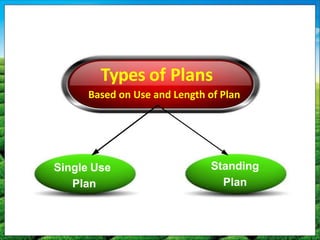Planning involves deciding in advance what needs to be done, how, when, and by whom to achieve predetermined goals. It is the primary function of management and a continuous process. Planning establishes direction, reduces uncertainty, avoids wasteful activities, promotes innovation, and facilitates decision making. While planning provides benefits, it also has limitations like rigidity, being time consuming and costly, and not guaranteeing success. The planning process involves setting objectives, developing premises, identifying alternatives, evaluating alternatives, selecting the best option, implementing plans, and following up. Types of plans include objectives, strategies, policies, procedures, rules, methods, programs, and budgets.























































